Charles E W Bean, Diaries, AWM38 3DRL 606/249/1 - 1917 - 1932 - Part 1
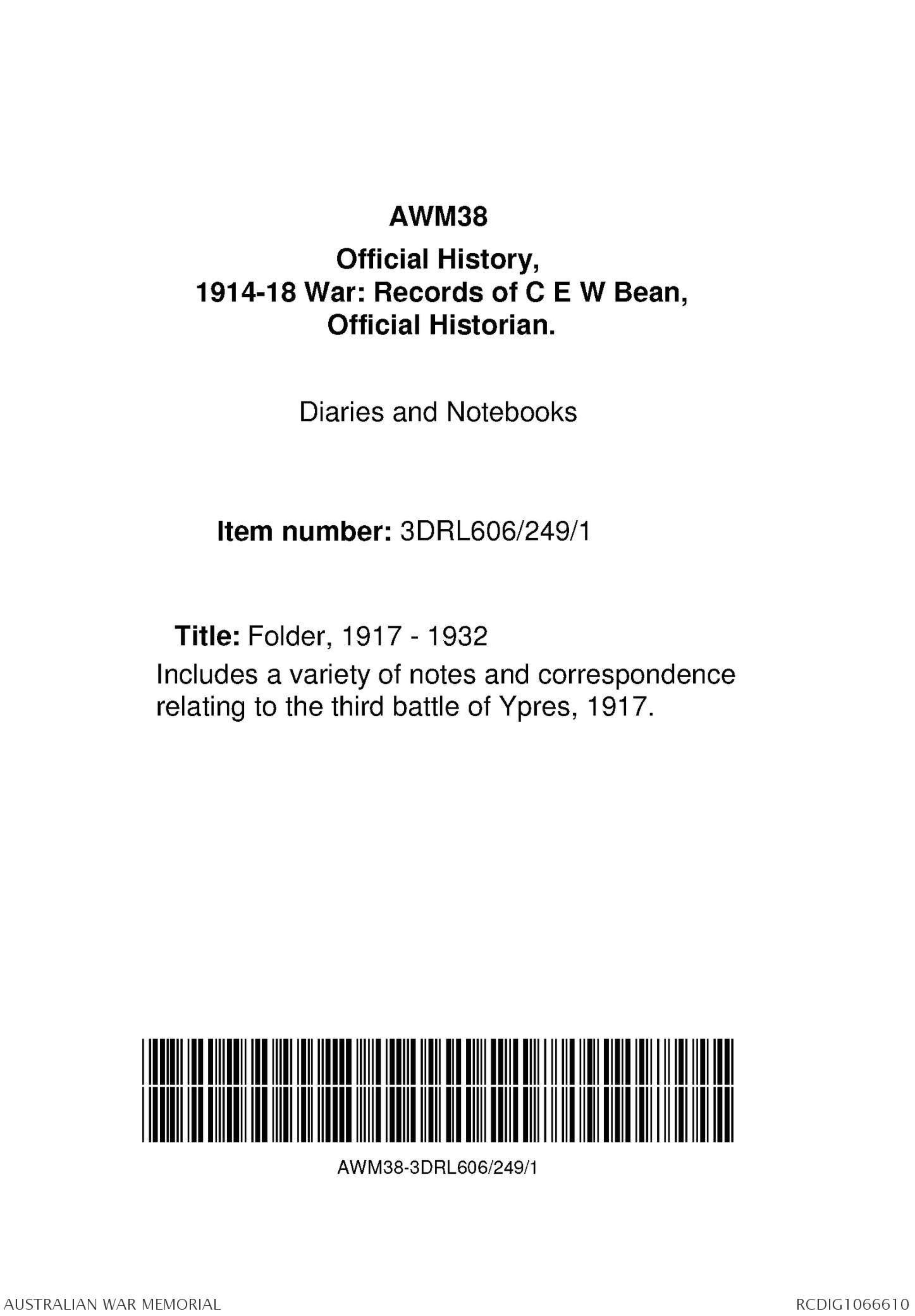
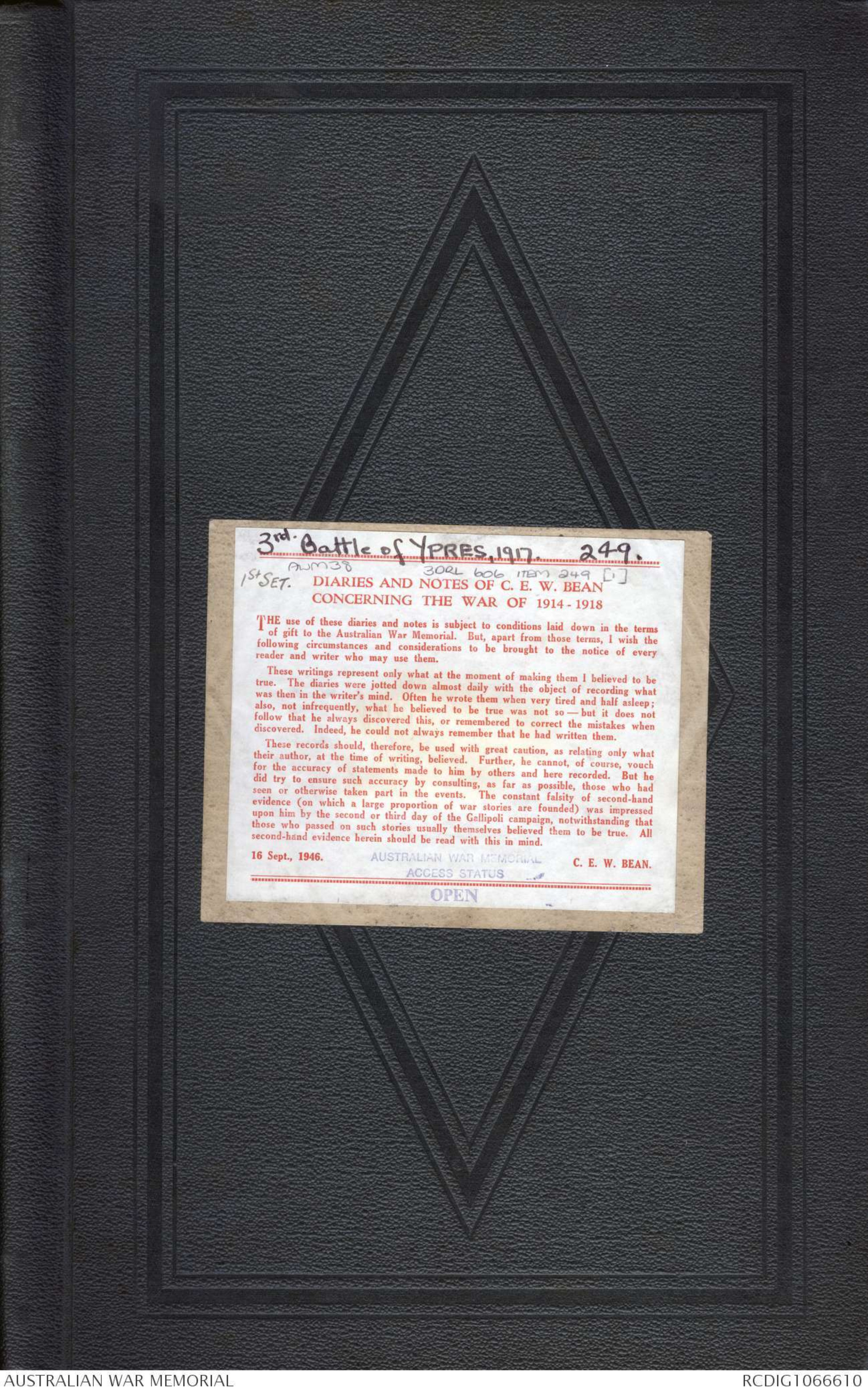

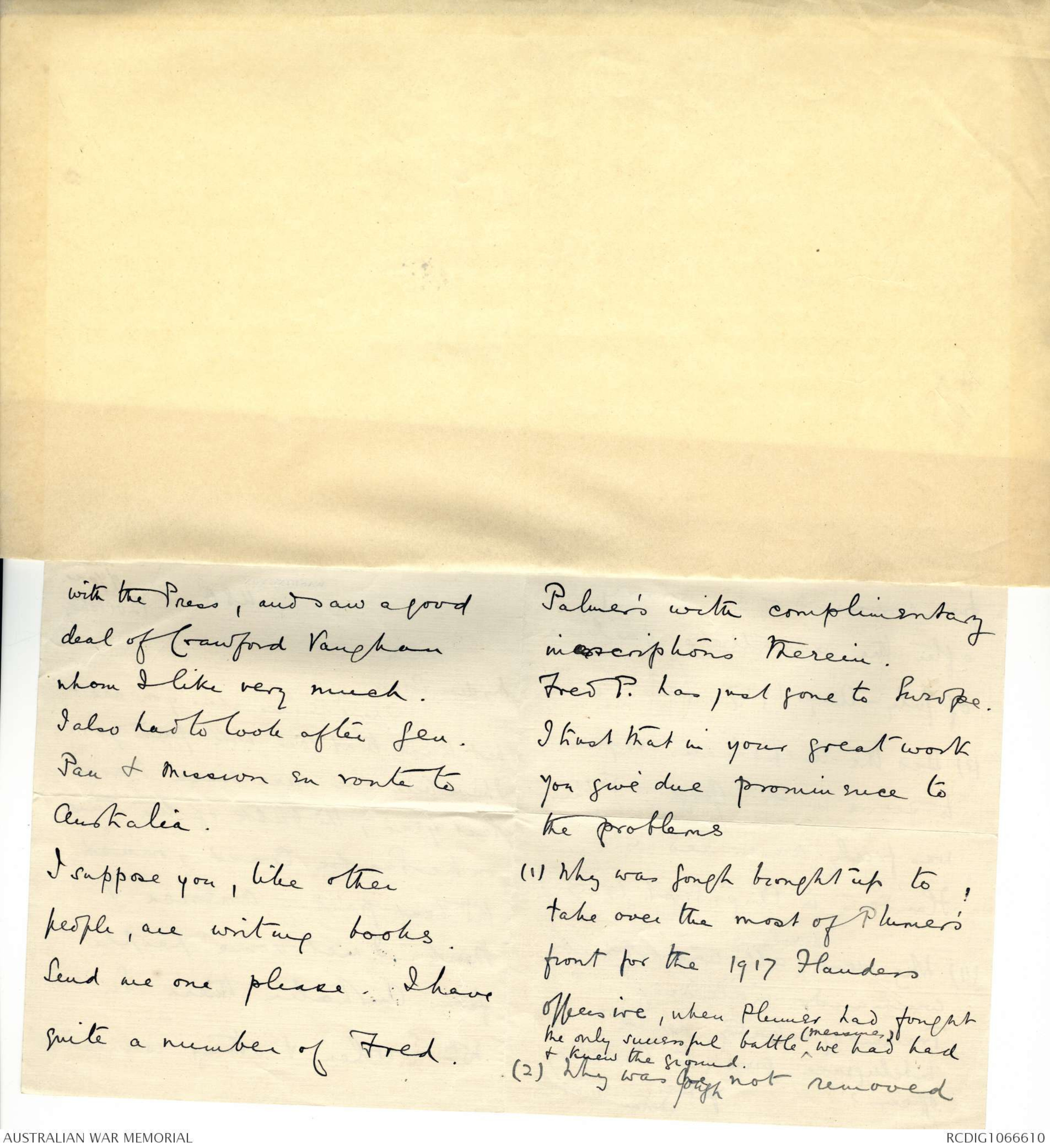

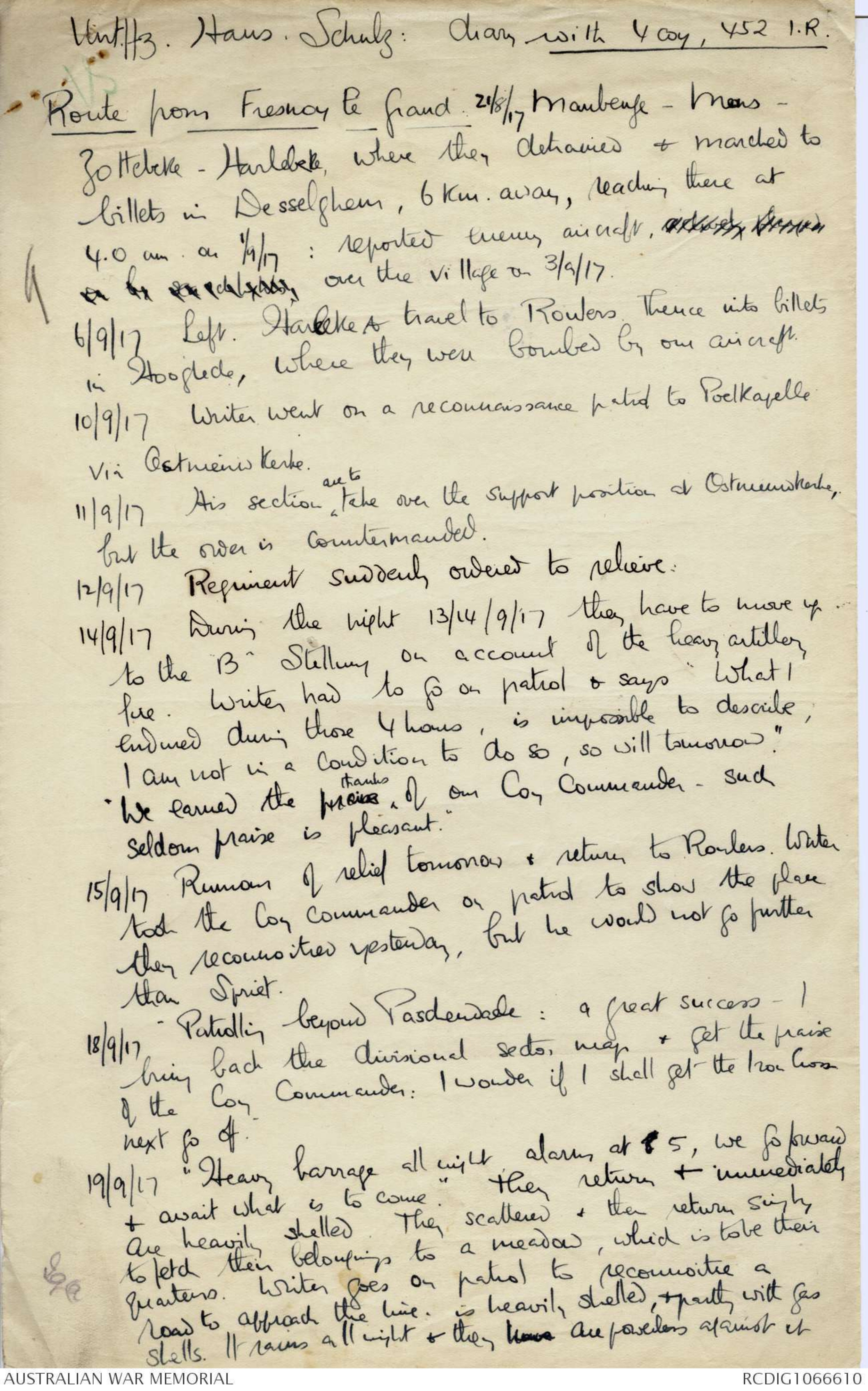
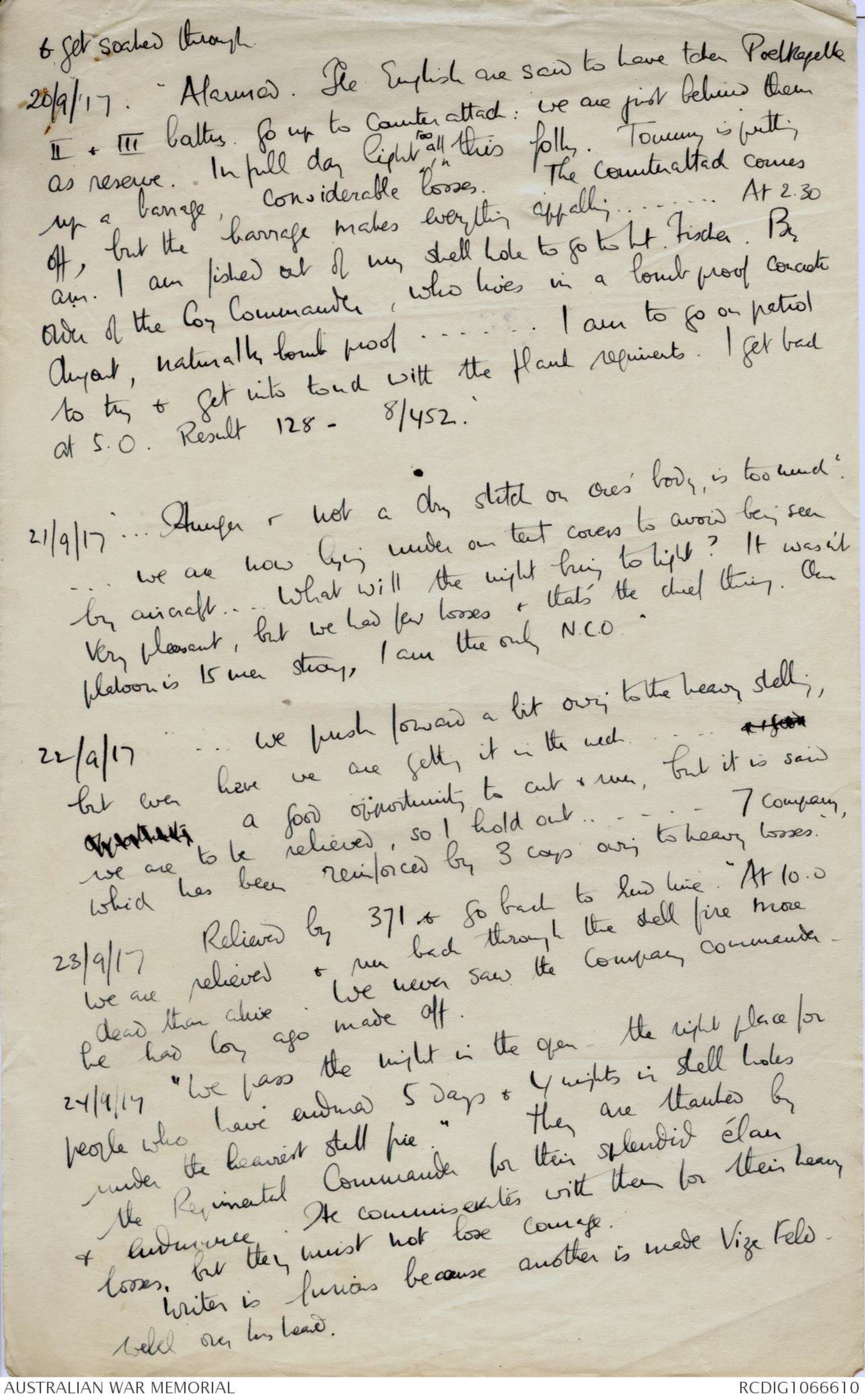
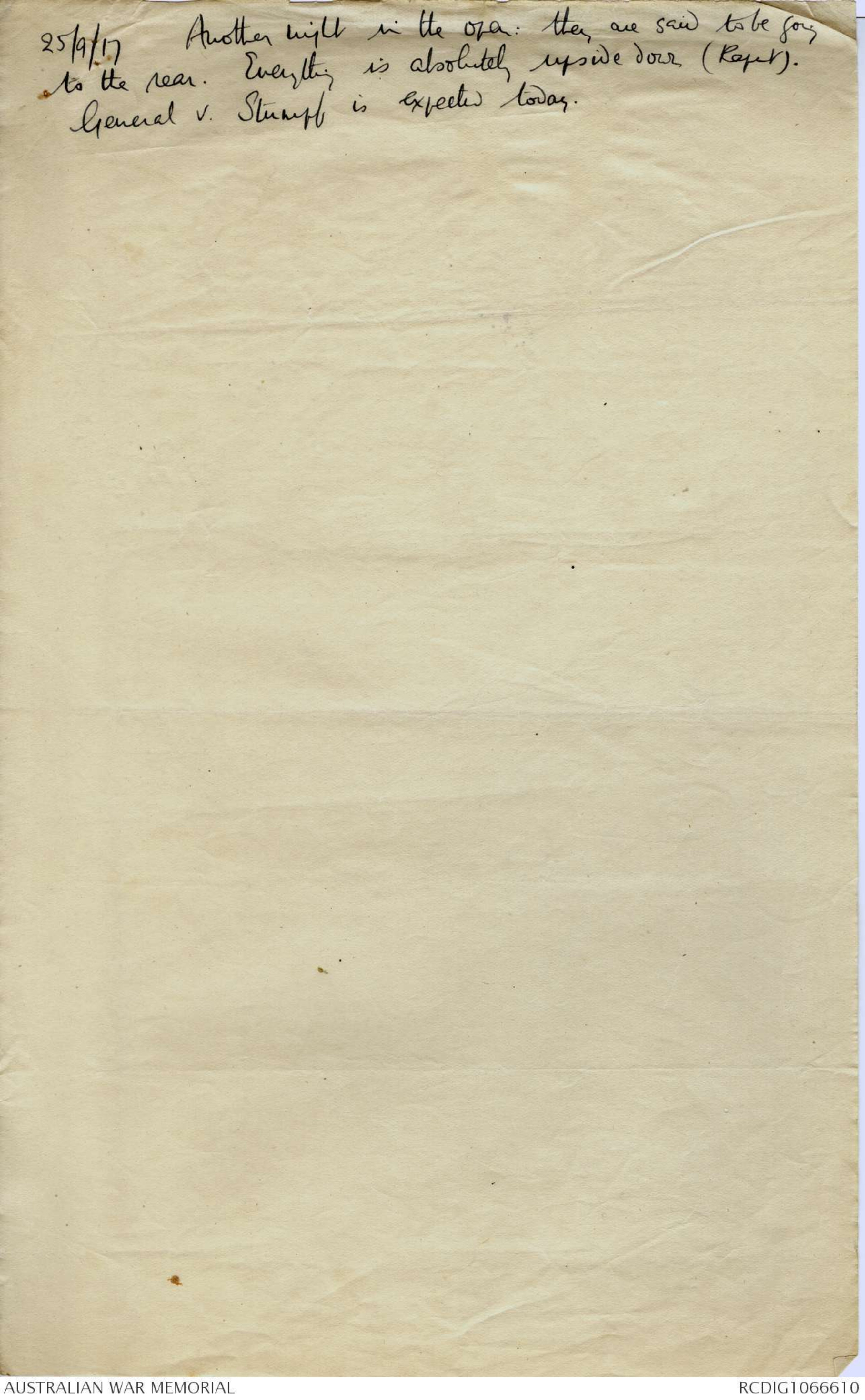

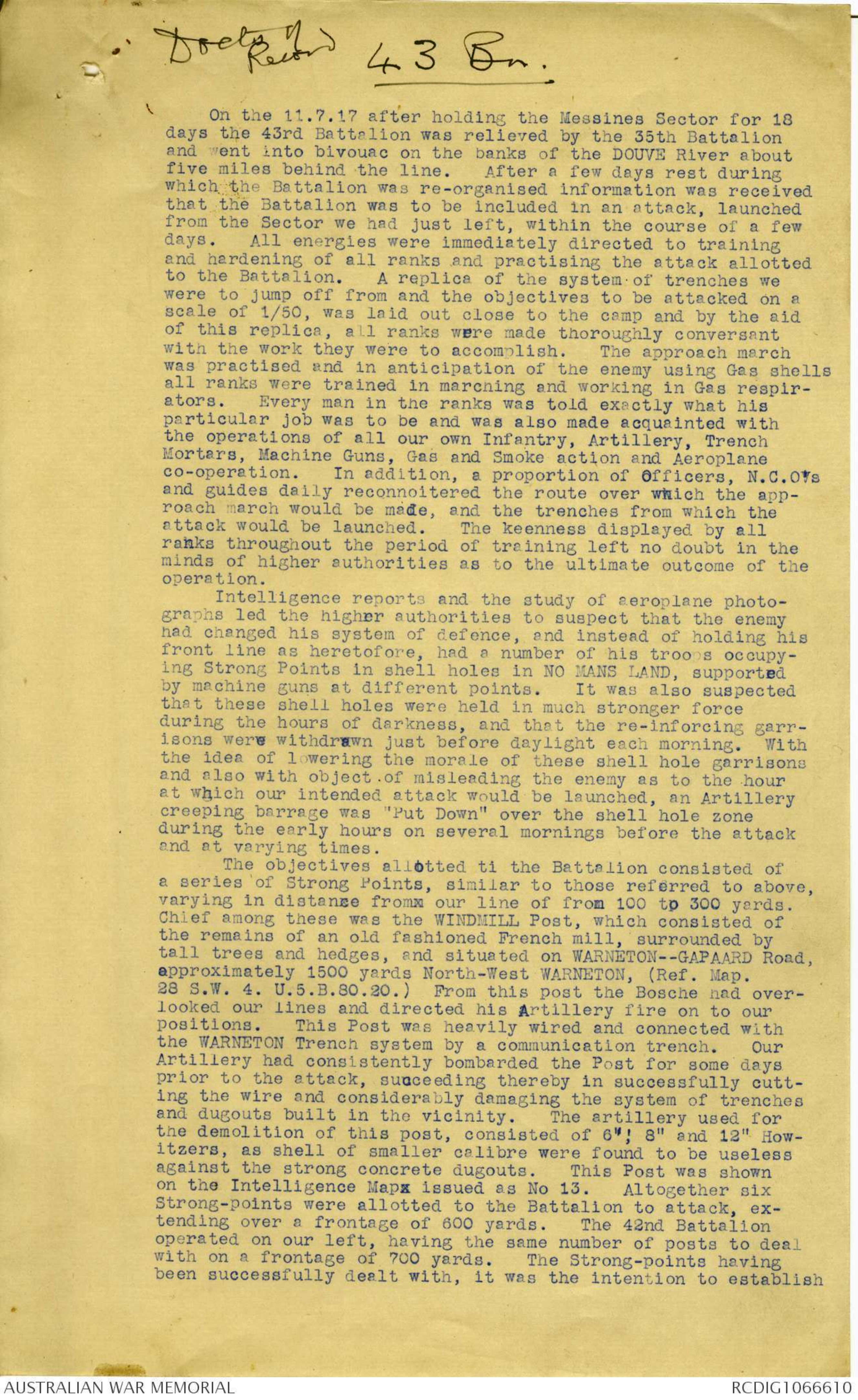
AWM38
Official History,
1914-18 War: Records of C E W Bean,
Official Historian.
Diaries and Notebooks
Item number: 3DRL606/249/1
Title: Folder, 1917 - 1932
Includes a variety of notes and correspondence
relating to the third battle of Ypres, 1917.
AWM38-3DRL606/249/1
3rd. Battle of YPRES, 1917. 249.
AWM 38 3DRL 606 ITEM 249 [1]
1st SET.
DIARIES AND NOTES OF C. E. W. BEAN
CONCERNING THE WAR OF 1914-1918
THE use of these diaries and notes is subject to conditions laid down in the terms
of gift to the Australian War Memorial. But, apart from those terms, I wish the
following circumstances and considerations to be brought to the notice of every
reader and writer who may use them.
These writings represent only what at the moment of making them I believed to be
true. The diaries were jotted down almost daily with the object of recording what
was then in the writer’s mind. Often he wrote them when very tired and half asleep;
also, not infrequently, what he believed to be true was not so —but it does not
follow that he always discovered this, or remembered to correct the mistakes when
discovered. Indeed, he could not always remember that he had written them.
These records should, therefore, be used with great caution, as relating only what
their author, at the time of writing, believed. Further, he cannot, of course, vouch
for the accuracy of statements made to him by others and here recorded. But he
did try to ensure such accuracy by consulting, as far as possible, those who had
seen or otherwise taken part in the events. The constant falsity of second-hand
evidence (on which a large proportion of war stories are founded) was impressed
upon him by the second or third day of the Gallipoli campaign, notwithstanding that
those who passed on such stories usually themselves believed them to be true. All
second-hand evidence herein should be read with this in mind.
16 Sept., 1946. C. E. W. BEAN.
AUSTRALIAN WAR MEMORIAL
ACCESS STATUS
OPEN
from command of an army
after the appalling failure
of July - Aug 1917. (Had Carson any
thing to do with this?)
(3) Did the Australians refuse
to serve under Gough? [This
was freely rumoured in
Flanders in Aug - Sept 1917]
(4) Why were ^nearly all important
commands including
Training of infantry and
Intelligence given to Cavalry
officers?
Yrs ever -
JC Faunthorpe
[*File with No.1. Copy Historical notes for 3rd Battle of Ypres.*]
British EmbassyTHE ARMY AND NAVY CLUB
Washington
USA
12 October
My dear Bean
I have no idea where you are
but trust that this will find you.
I have been over here since March
last year, the bulk of the time
on the Pacific Coast, much
the best part of America I
think. I met some people
from Australia there Sir
Wm Sowden & others connected
with the Press, and saw a good
deal of Crawford Vaughan
whom I like very much.
I also had to look after Gen.
Pau & Mission en route to
Australia.
I suppose you, like other
people, are writing books.
Send me one please. I have
quite a number of Fred.
Palmer's with complimentary
inscriptions therein.
Fred P. has just gone to Europe.
I trust that in your great work
you give due prominence to
the problems
(1) Why was Gough brought up to,
take over the most of Plumer's
front for the 1917 Flanders
offensive, when Plumer had fought
the only successful battle ^(Messines) we had had
& knew the ground.
(2) Why was Gough not removed
Third Battle of Ypres
see Nineteenth Century magazine
Feb 1921
La Bataille des Flandres in 1917
By General Verreaux
See Army Quarterly Vol IX
article by Gen Edmonds
Colonel Toll's papers
Untffz. Hans. Schulz: diary with 4 coy, 452 I.R.
Route from Fresnoy le Grand 21/8/17 Maubeuge - Mons -
Zoltebeke - Harlebeke, where they detrained & marched to
billets in Desselghem, 6 km. away, reaching there at
4.0 am. on 1/9/17: reported enemy aircraft actively playedon be seachlight over the village on 3/9/17.
6/9/17 Left. Harlebeke to travel to Roulers thence into billets
in Hooglede, where they were bombed by our aircraft.
10/9/17 Writer went on a reconnaissance patrol to Poelkapelle
via Oostnieuw Kerke.
11/9/17 His section, ^are to take over the support position at Oostnieuwkerhe,
but the order is countermanded.
12/9/17 Regiment suddenly ordered to relieve.
14/9/17 During the night 13/14 /9/17 they have to move up
to the "B" Stellung on account of the heavy artillery
fire. Writer had to go on patrol & says " What I
endured during those 4 hours, is impossible to describe,
I am not in a condition to do so, so will tomorrow."
"We earned the praise thanks of our Coy Commander - such
seldom praise is pleasant."
15/9/17 Rumour of relief tomorrow & return to Roulers. Writer
took the Coy commander on patrol to show the place
they reconnoitred yesterday, but he would not go further
than Spriet.
18/9/17 Patrolling beyond Paschendaele : a great success - I
bring back the divisional sects. map & get the praise
of the Coy Commander. I wonder if I shall get the Iron Cross
next go off.
19/9/17 "Heavy barrage all night alarms at 8 5, we go forward
& await what is to come." They return & immediately
are heavily shelled. They scattered & then return singly
[[*Iga?*]]
to fetch their belongings to a meadow, which is to be their
quarters. Writer goes on patrol to reconnoitre a
road to approach the line. is heavily shelled, & partly with gas
shells. It rains all night & they have are powerless against it
& get soaked through.
20/9/17. Alarmed. The English are said to have taken Poelkapelle
II & III battery go up to counter attack: we are just behind them
as reserve. In full day light ^too all this folly. Tommy is putting
up a barrage, Considerable losses. The counter attack comes
off, but the barrage makes everything appalling . . . . At 2.30
a.m. I fished out of my shell hole to go to Lt Fischer. By
Order of the Coy Commander, who lives in a bomb proof concrete
dugout, naturally bomb proof . . . . . I am to go on on patrol
to try to get into touch with the flank regiments. I get back
at 5.0 Result 128 - 8/452.
21/9/17 ". . . Hungry & not a dry stitch on one's body is too much"
. . . We are now lying under our tent covers to avoid being seen
by aircraft . . . .What will the night bring to light? It wasn't
very pleasant, but we had few losses & that's the chief thing. Our
platoon is 15 men strong, I am the only N.C.O.
22/9/17 ". . . .We push forward a bit over to the heavy shelling,
but over here we are getting it in the neck... & / good opportunity a good opportunity to cut & run, but it is said
we are to be relieved, so I hold out ...... 7 Company,
which has been reinforced by 3 coys owing to heavy losses.
23/9/17 Relieved by 371 to go back to 2nd line. "At 10.0
we are relieved & run back through the shell fire more
dead than alive. We never saw the Company commander
he had long ago made off.
24/9/17 "We pass the night in the open the right place for
people who have endured 5 days & 4 nights in shell holes
under the heaviest shell fire." They are thanked by
the Regimental Commander for their splendid ėlan
& endurance. He commiserated with them for their heavy
losses, but they must not lose courage.
Writer is furious because another is made Vize Feldwebel
over his head.
25/9/17 Another night in the open: they are said to be going
to the rear. Everything is absolutely upside down (Kaput)
General v. Stumpf expected today.
BATTLE OF PILCKEM RIDGE, 31 July to 2 August 1917.
Extract from the Melbourne "Herald", 1 January 1918.
Acting Bombardier Reginald E. Hannaker (No. 14626) who died
from gunshot wounds on November 16, at the front, gave promise of a
brilliant career in his school days, and was not lacking in bravery;
on the battlefield.
He was educated at the High Street State School, Prahran, and
Albert Park Grammar School. At the state school he won the dux medal
for his grade, and at the grammar school gained prizes and distinction
When in his thirteenth year he gained first prize for a coloured
map of Victoria, and was requested by Mr. E. Toms, the principal of
Albert Park Grammar School, to do six commercial maps, each 3 feet 6
by 2 feet 6, which are on the class-room walls for the use of pupils.
He enlisted in October 1915, and after a short period in camp at
Royal Park was transferred to the artillery, leaving Australia in May
1916. He experienced his first battle in Easter 1917, and when he
died was 19 years of age.
In the last letter received by his parents, Mr. and Mrs. F.
Hannaker, "Kincora" , Canterbury Road, Middle Park, he stated that he
was fit and ready to give Fritz some more anxious moments as soon as
the order came to move. "I have a boil on my arm", he added, "but
take no notice of it. It is the fourteenth I have had in a couple of
months, all between the wrist and elbow. When I was in the big
attack in the beginning of August I had seven."
When we ceased firing at midday on August 1 I had xt discarded
my tunic. My shirt was wringing wet with perspiration, sleeves
rolled up, both arms in bandages from wrist to elbow, hands blistered
and singed from the flame when the breech was opened and minus a few
pieces of skin from my fingers, knocked off goodness only knows how.
1 looked like a penny dreadful melodrama hero, but in this big piece
I was only one of the toys; we were all alike. We had been firing
for 12 hours, and, believe me, going some.
"Opening up at midnight on July 31, we sent over gas shells till
the attack proper mxand opened at 3.50 a.m. on August 1. From that
time on we were firing high explosives. When we ceased firing the
guns were so hot you could have boiled water on them, and there was
a smoke haze screening the landscape. The din! Terrific is thefirst xxx that comes to my mind first word that comes to my mind, but
it is a poor one to describe it.
"When I was getting my boils dressed one of our officers wanted
to send me back to the waggon, so did our sergeant; but I laughed
at the proposal, pleaded with them to let me continue, and had my
way. I remained right through the piece until Fritz took a hand.
Our sergeant was sent back to the waggon lines for a rest, and I
took charge of the gun. Two days after it was blown up - a direct
hit. We had another up the same night, and it, too, was completely
wrecked by one of Fritz's shells, which blew the whole concern 50
yards away, strewing the landscape with the pieces. I have never
seen such a mess as that gun looked. We were out of a job then, as
they could not replace that gun immediately; so I and the men had
to go back to the waggon lines after five weeks of the liveliest
time I have yet experienced. A week later the battery pulled out
for a spell. I have the satisfaction of knowing that I have been in
one big push."
(Note: Bdr. Hannaker was aged 19 years & 8 months at the time
of his death)
[*Docts of
record*]
43 BN
On the 11.7.17 after holding the Messines Sector for 18
days the 43rd Battalion was relieved by the 35th Battalion
and went into bivouac on the banks of the DOUVE River about
five miles behind the line. After a few days rest during
which the Battalion was re-organised information was received
that the Battalion was to be included in an attack, launched
from the Sector we had just left, within the course of a few
days. All energies were immediately directed to training
and hardening of all ranks and practising the attack allotted
to the Battalion. A replica of the system of trenches we
were to jump off from and the objectives to be attacked on a
scale of 1/50, was laid out close to the camp and by the aid
of this replica, all ranks were made thoroughly conversant
with the work they were to accomplish. The approach march
was practised and in anticipation of the enemy using Gas shells
all ranks were trained in marching and working in Gas respirators.
Every man in the ranks was told exactly what his
particular job was to be and was also made acquainted with
the operations of all our own Infantry, Artillery, Trench
Mortars, Machine Guns, Gas and Smoke action and Aeroplane
co-operation. In addition, a proportion of Officers, N.C.O's
and guides daily reconnoitered the route over which the approach
march would be made, and the trenches from which the
attack would be launched. The keenness displayed by all
ranks throughout the period of training left no doubt in the
minds of higher authorities as to the ultimate outcome of the
operation.
Intelligence reports and the study of aeroplane photographs
led the higher authorities to suspect that the enemy
had changed his system of defence, and instead of holding his
front line as heretofore, had a number of his troops occupying
Strong Points in shell holes in NO MANS LAND, supported
by machine guns at different points. It was also suspected
that these shell holes were held in much stronger force
during the hours of darkness, and that the re-inforcing garrisons
were withdrawn just before daylight each morning. With
the idea of lowering the morale of these shell hole garrisons
and also with object of misleading the enemy as to the hour
at which our intended attack would be launched, an Artillery
creeping barrage was "Put Down" over the shell hole zone
during the early hours on several mornings before the attack
and at varying times.
The objectives allotted ti the Battalion consisted of
a series of Strong Points, similar to those referred to above,
varying in distance fromx our line of from 100 to 300 yards.
Chief among these was the WINDMILL Post, which consisted of
the remains of an old fashioned French mill, surrounded by
tall trees and hedges, and situated on WARNETON--GAPAARD Road,
approximately 1500 yards North-West WARNETON, (Ref. Map.
28 S.W. 4. U.5. B.80.20.) From this post the Bosche had overlooked
our lines and directed his Artillery fire on to our
positions. This Post was heavily wired and connected with
the WARNETON Trench system by a communication trench. Our
Artillery had consistently bombarded the Post for some days
prior to the attack, succeeding thereby in successfully cutting
the wire and considerably damaging the system of trenches
and dugouts built in the vicinity. The artillery used for
the demolition of this post, consisted of 6"; 8" and 12" Howitzers,
as shell of smaller calibre were found to be useless
against the strong concrete dugouts. This Post was shown
on the Intelligence Mapx issued as No 13. Altogether six
Strong-points were allotted to the Battalion to attack, extending
over a frontage of 600 yards. The 42nd Battalion
operated on our left, having the same number of posts to deal
with on a frontage of 700 yards. The Strong-points having
been successfully dealt with, it was the intention to establish
 Maralyn K
Maralyn KThis transcription item is now locked to you for editing. To release the lock either Save your changes or Cancel.
This lock will be automatically released after 60 minutes of inactivity.